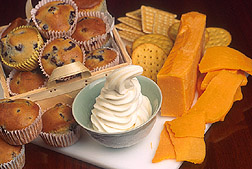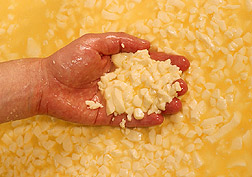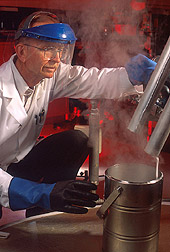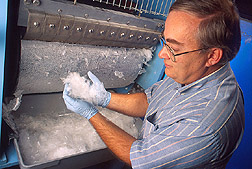Fantastic Fantesk
|
|
|
|
Families searching for tasty cheeses with only a fraction of the fat and cholesterol of full-fat cheeses may soon find them in the supermarket. Such cheeses may be made with a natural product called Fantesk™. Cheese is one of the most recent Fantesk products to enter the research arena. But many more Fantesk-containing products may benefit consumers as well as farmers hoping for new markets.
Fantesk is a mixture of starch, water, and one or more oily substances—such as the butterfat in cheese. Its name is one of the names trademarked by USDA, including Smokey Bear™. The product stems from a patented invention in the mid-1990s by Agricultural Research Service scientists at the National Center for Agricultural Utilization Research (NCAUR), in Peoria, Illinois. Scientists showed that, contrary to an old axiom, water and oildo mix—under certain conditions. So researchers and industry cooperators are developing an array of new food, industrial, agricultural, medical, and cosmetic products.
|
|
|
Fantesk was created by ARS chemists George F. Fanta and the late Kenneth Eskins. They processed starch and an oil, such as soy oil, together in superheated steam under pressure and noted the unusual nature of a gel that came out of the jet cooker. Whether the gel was melted into a liquid, frozen and then thawed, or drum-dried into a solid, flaky material and then milled into powder and redispersed in water, the tiny droplets of oil remained well distributed in the starch, with nary a greasy feel. Some formulations contained up to 70 parts oil by weight per 100 parts of starch.
Mixtures that include only small amounts of vegetable oils or animal fats may be used to make foods much lower in fat than their conventional counterparts. Take cheese, for example. The fat content of full-fat cheese is 34 percent or more, and low-fat cheeses normally have about half as much fat. "We believe we can develop a low-fat cheese of comparable flavor with less than 12 percent butterfat or even a tasty product that, according to federal regulation, could be called a no-fat cheese, having less than 3 percent fat," says postdoctoral food technologist Gul Uludogan. Preliminary sensory and taste tests on mild cheddar cheeses that she's made suggest she's probably right. Uludogan works in NCAUR's Biomaterials Processing Research Unit, headed by physical scientist Craig J. Carriere. |
|
|
More Food Applications The tiny oil droplets in Fantesk are ideal places to encapsulate certain fat-soluble compounds that give foods flavor. Under an agreement with ARS, Azure Waves Seafood Inc., Cincinnati, Ohio, is developing seafoods seasoned with herbs and spices in a Fantesk breading. Putting butterfat into Fantesk is Uludogan's secret for making her extremely low-fat cheese. Likewise, research is under way at NCAUR to develop tasty cookies and muffins with fewer fat calories than conventional baked goods. NCAUR physical scientist G. Astrid Garzon found only slight differences in physical properties, such as texture, between cookies made by a standard recipe and ones made with Fantesk with 30 percent less fat. She overcame those differences by adding emulsifiers, such as lecithin, to the recipe. In 1999, NCAUR chemical engineer Jeffrey A. Byars began researching processes for making soft-serve low-fat ice cream with Fantesk. Within a year, he found a Fantesk formulation that was just right for the job. |
|
|
"Using a small amount of butter in Fantesk instead of cream lets us make a lower-fat ice cream with full-fat flavor," he says. In informal tests, Byars and his colleagues found a Fantesk-containing soft-serve with 1.1 percent fat had similar taste and mouth feel as a commercial 3.5 percent-fat soft-serve. Conventional soft-serves contain up to 8 percent fat. ARS is seeking a commercial partner to speed development of ice cream with an extremely low fat content. Most of Byars' Fantesk research involves the jet-cooking process for making the product. Fantesk is a family of materials, he says, and different starches, oils, and processing conditions affect its physical properties and suitability for various uses. The knowledge and experience NCAUR scientists have gained so far is helping them develop scaled-up production for additional commercial partners who would like to test Fantesk's potential for further applications. |
|
|
Agrochemicals Since Fantesk was invented (see "A Fantesk-tic Starch-Oil Combo,"Agricultural Research, September 1995, pp. 12–14), interest in its physical properties has led to many cooperative research and development agreements (CRADAs) and other types of cooperative endeavors involving licensing, material transfer, and confidentiality agreements with commercial firms. The first commercial sales of a Fantesk product—a seed coating—were in late 1999. The technology was rooted in a 1994 CRADA between ARS and Seedbiotics Inc., of Caldwell, Idaho. "During a 3-year collaboration, Seedbiotics tested a wide variety of our formulations," said ARS chemist Frederick C. Felker. Two years into the CRADA, the company obtained an exclusive license to coat seeds with Fantesk and has since independently developed specific formulations. For example, a unique combination of starch, lipid materials, and plasticizers—for pliability—helps regulate seeds' water uptake in cold, wet soils, enhancing germination and crop establishment for legumes. Agricultural chemicals such as fungicides can be mixed with the seed coatings.
|
|
|
Under the CRADA with Seedbiotics, Felker and his colleagues built an experimental jet-cooking batch system. That experience helped the scientists build a newer version, and they're now working on a continuous-processing system in NCAUR's recently renovated pilot plant.
The plant offers confidence-building experiences as processes and equipment are tested on a scale large enough to make economic assessments, says Peter B. Johnsen, center director. (See "Pilot Plants Push Tech Transfer,"Agricultural Research, August 2000, pp. 20–22.) Other potential agricultural applications of Fantesk include sprays, coatings for nursery stock, and livestock feed additives. Medical Uses Large amounts of Fantesk will be manufactured for research and product use under one of the newest CRADAs—with Hy-Gene Biomedical Corporation, of Ventura, California. Hy-Gene holds an exclusive license for all topical therapeutics and drug delivery, as well as skin-and wound-care medical applications. The ARS researchers will initially operate NCAUR's pilot facilities and produce the 1,000-gallon pilot lots of Fantesk required to complete the technology transfer. Among the first formulations is a barrier cream for use by the health care market. The product is designed as a superior skin protectant and antimicrobial skin barrier lotion. Long-term research and development under the CRADA will focus on products to promote wound healing and to deliver pharmaceuticals to exterior and interior body linings. Fanta and his colleagues will test Hy-Gene's preparations for qualities such as the size and distribution of oil droplets, the manner in which they flow, and their stickiness and lubricity. Hy-Gene has successfully completed a prospective randomized human clinical trial of Derm-Care, its trade name for a line of skin- and wound-care products. The results demonstrated that Fantesk technology can be used to make a barrier cream with superior properties. Hy-Gene plans to begin pilot operations at NCAUR under an extended CRADA with USDA and to begin test marketing the barrier cream this year. In another medical application, Fantesk may be used as a vehicle to carry injectable pharmaceuticals dissolved in the 0.1- to 10-micron-diameter oil droplets to the circulatory systems of humans and other animals. And in cooperative research involving NCAUR and the Peoria branch of the University of Illinois Medical School, scientists gave laboratory rabbits intramuscular or intravenous injections of solutions containing Fantesk. No allergic reactions occurred at the injection site. Today, some injectable human drugs are enveloped in tiny packets of phospholipids, which become permeable at body temperature. The drugs are then released into the bloodstream. But for most veterinary applications a liposome delivery system is too expensive. That's one reason member companies of the Biotechnology Research and Development Corporation, in Peoria, became interested in NCAUR's Fantesk technology. They'll fund further research on veterinary applications. Industry Awaits New Efficiency Chemist Selim M. Erhan, recently of NCAUR, researched Fantesk as a component in metalworking fluids. Manufacturers annually use 500 million gallons of these fluids to reduce excess friction in drilling, grinding, and cutting. Water-based fluidscalled semisynthetics—pose fewer disposal problems and disperse heat better than oil-based fluids. For those reasons, semisynthetics are becoming more widely used. Those made with Fantesk offer the additional advantage of having no toxic emulsifiers. In another metalworking arena, Fantesk may one day be used to lubricate dies, which shape sheet metal into objects such as automobile roofs. If a die sticks to a metal surface, it prevents the metal from bending evenly, creating thin, weak regions. As a lubricant carrier, Fantesk may soon become an environmentally friendly additive to oil-drilling muds, which are used to reduce drill bit wear. The drilling industry uses about 30 million pounds of starch as a component of muds to line bore holes, making their walls less likely to cave in. Fanta, Felker, Erhan, and Shrieve Chemical Products, Inc., Woodlands, Texas, working under a CRADA, invented a way to use a Fantesk formulation as a water-based drilling-mud additive. The additive would increase the amount of starch in drilling mud by two-thirds. Says Erhan, "Besides decreasing the amount of lubricant needed for drilling, routine use of Fantesk would greatly increase the amount of low-cost starch the agricultural industry could sell to the petroleum drilling industry." Testing by the Westport Technology Center, an independent testing facility used by the drilling industry, showed the Fantesk product had lubricity similar to that of oil-based muds. The CRADA has been extended a year for field testing. Although oil-based drilling-mud additives have until now worked better than those made with water, the market has recently shifted toward water-based muds because they are less costly. They're also less toxic to creatures in the environment. "We expect an excellent market for Fantesk lubricants, especially for offshore drilling in Europe and other places where regulations regarding biodegradability and toxicity are especially stringent," says Herman M. Muijs, technical product manager for Shrieve Chemical.—By Ben Hardin, Agricultural Research Service Information Staff. This research is part of New Uses, Quality, & Marketability of Plant & Animal Products (#306), an ARS National Program described on the World Wide Web at http://www.nps.ars.usda.gov. Craig J. Carriere and other scientists mentioned in this article are with the USDA-ARS National Center for Agricultural Utilization Research, 1815 N. University Street, Peoria, IL 61604; phone (309) 681-6551, fax (309) 681-6685. |
|
"Fantastic Fantesk" was published in the February 2001 issue of Agricultural Research magazine. |
|












